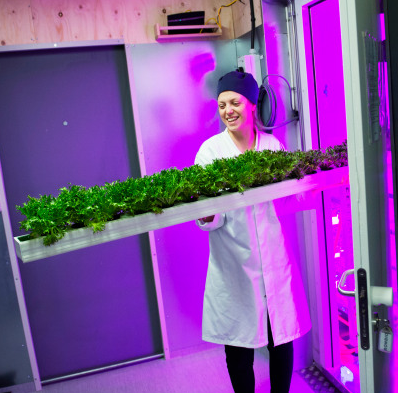Outside the IKEA stores in Malm? and Helsingborg, Sweden, there are containers, and IKEA is trying to grow lettuce inside. It is expected that these vegetables will be supplied to the nearby store restaurant soon.

For IKEA, this is a step towards environmental sustainability. Catarina Englund, Ingka Group, which manages IKEA’s near-global stores, said: “We need to find a better way to produce healthier food, use less land and water, and reduce food waste. ”
“Urban farming can focus on producing local, fresh ingredients while consuming less natural resources to meet the needs of neighboring areas, and thus has the potential to change the current food value chain.”
In each container, the hydroponic planting system can grow 4 layers of plants, up to about 3,600 lettuce plants. There is no soil, no pesticides or herbicides, and like other indoor farming systems, this system uses 90% less water than planting on the ground. The LED lights hanging above the plants use renewable energy to help the plants grow quickly.
In addition, the restaurant will also use food waste to transform it into nutrients needed for lettuce. Fredrik Olrog, co-founder and managing director of Bonbio, the supplier of IKEA’s indoor planting system, said: “The raw materials we use to fertilize are made from kitchen waste, and this is what makes us unique: we try to make the farm is in line with the spirit of circular economy.”
The hydroponic planting system can grow 4-layer plants. There is no soil, no pesticides or herbicides. The LED lights hanging above the plants use renewable energy to help plants grow quickly.
Bonbio’s parent company, OX2, is an enterprise that specializes in refining oil from food waste. In the process of oil production, by-products such as nitrogen and phosphorus are produced, which can provide important sources of nutrients for crops, and OX2 has also found a way to extract these nutrients as fertilizers. In other words, the food waste produced by the IKEA restaurant can be used to help more crops grow.
“Bonbio operates a completely closed loop system in two IKEA in Sweden-we did use the food waste from the IKEA restaurant to make IKEA’s own dishes grow better.” Olrog said.
Speaking of the cooperation with Bonbio, Englund said: “We will explore how to grow fresh, healthy and sustainable salad lettuce in vertical farms at a cost that is not higher than traditional cultivation to achieve self-sufficiency.”
Regarding why this indoor planting project started with leafy vegetables, Englund explained: “As far as the situation is concerned, it is easiest to grow vegetables with a short growth cycle and high yield per unit area, such as lettuce and cabbage.”
In Sweden, lettuce has long relied on foreign imports. The winter here is cold and gloomy, which makes this place an excellent place to test the system. Vegetables grown on the ground not only taste better, but also avoid emissions caused by transportation. In a one-year test, Ingka and Bonbio will study how much lettuce this system can produce and how the nutrients currently used affect the nutritional value of the end food.
Englund explained: “Our goal is to prove that the concept of vertical farms is feasible under the operation of IKEA, and to establish and optimize the implementation process.” In these two pilot stores, IKEA expects to supply this batch of lettuce to employee restaurants first. When the manufacturing process is more mature, it will be officially supplied to retail restaurants.
Although for IKEA, food only accounts for a very small part of the company’s overall carbon footprint, as a whole, as the whole company pays more and more attention to sustainable practices, such as moving towards a circular economy model, and recently trying to implement “furniture leasing”, working hard on ingredients is also part of the solution to carbon reduction.
Globally, more than 30% of emissions that affect the climate are related to food. In addition to adding vegetable balls, vegetable hot dogs and other vegetable-based meals to the store menus, IKEA is also committed to halving food waste. Their next step is to grow their own ingredients, and ultimately hope to make IKEA’s carbon reduction greater than its carbon emissions-that is, to promote to the realm of climate positive.










